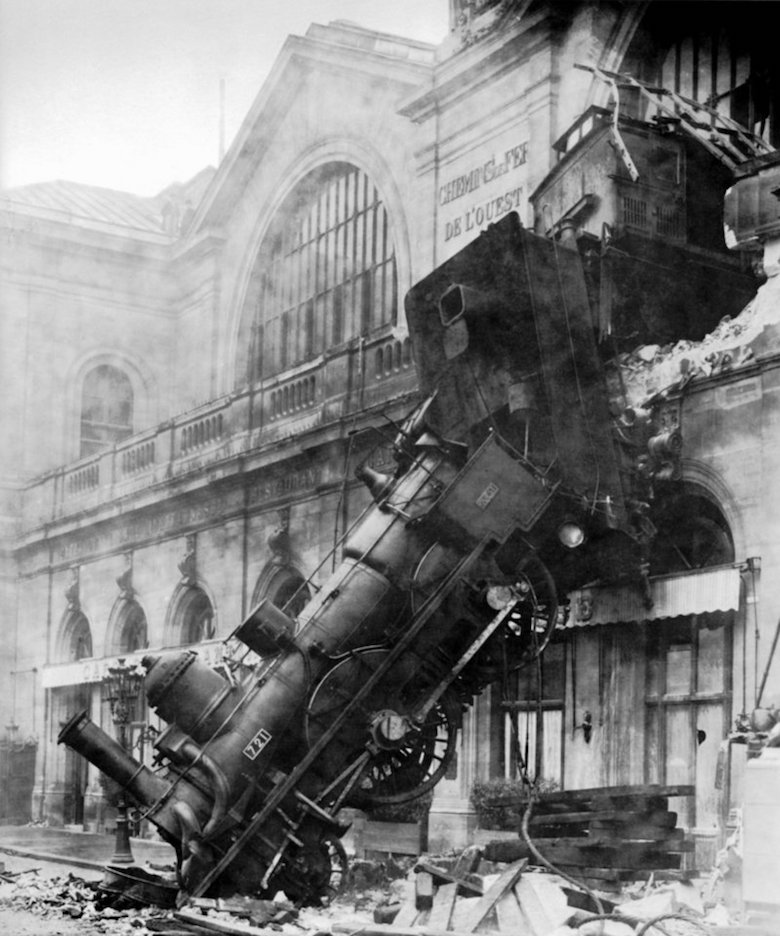I recently watched the charming 2011 film Hugo set in 1931 about an orphaned boy who, trying to avoid being sent to an orphanage, lives secretly in a railway station in Paris in the area where the large clock tower is. The film is directed by Martin Scorsese and is quite different from the gangster films that he is famous for. A key scene involves a train whose brakes fail and it crashes through the barriers at the end of the track and out of a window before falling to the street below. The idea for this was based on an actual accident that occurred in 1895 in the Montparnasse terminal and was captured in this iconic photograph.
I was curious as to how this scene was filmed and a major part of it was done not purely with CGI but using actual models 1/4 the size of the original. Matthew Gratzner, the visual effects supervisor, walks us through the process.
This video shows more of the painstaking and detailed work that went into it.
To me there are still some puzzling elements such as how they wove the model footage with the real people scrambling out of the way of the train. But it was a truly remarkable piece of special effects filmmaking and it deserved the five Academy Awards it won in those categories.


Looks like the model footage would have been shot on a greenscreen, too, then composited in. Or, possibly the people running were digital creations (like all the elves and orcs in the big battles in Lord Of The Rings and many other movies) -- a composite action scene can be made of many layers.
The reason Blade Runner still makes SFX fans cheer is because many of its scenes were composited on film -- which entailed filming part of a scene with a camera that had a mask installed in front of the film, then rewinding the film and exposing it again with a different mask, etc. You had to really really understand exposure, and the shot, and the lighting, etc.
Making great scenes will never be easy because of the creativity involved (which is why “look! Explosions!” Cinematics don’t get far) but there are some really cool new tools coming available. Probably the neatest is one WETA built, which renders the 3d elements into the scene in real-time, so what the camera operator sees is close to what the scene will look like.
My father was a great model maker who specialized in HO scale trains.
As a boy his model kits consisted of blocks of wood that he learned to carve into models of WW II aircraft. At one point in my young career I thought how great it would be to do the models—mostly ships—that I saw in movies. Today I cannot look at SF movies without pausing to study the details on the space ships.
Model making has mostly disappeared. Every once in a while I’ll ask students (usually when discussing ratios and scales—HO is 1/87 for instance) if they’ve ever built a model and all I get are blank looks.
I can guarantee you that the question “should we throw out the plates and just do it all digitally?” was asked more than once on that show.
Duncan Jones’s film Moon was a good example of resurrecting model-making for a thoroughly modern film. (Possibly, iirc, he brought in expert model makers with credits such as Alien.)
For the Moon film, the strengths of using real models over digital reconstructions were clear both on big screens and on small. The digital effects were limited to creating displays, compositing shots through windows, layering etc where digital excels anyway.
Moon is well worth a re-watch: Sam Rockwell is excellent. (Ignore the actor doing Gerty’s voice, though, in retrospect, it does give an extra creepy tone.)
EigenSprocketUK @#4,
Thanks for the recommendation. I am always on the lookout for good films to see and will likely watch it over the weekend.
Yeah… the digital effects on Moon were not quite as limited as advertised (unsurprisingly, they never are), in fact, in a number of close up shots, the models were enhanced with digitally added surface detail in addition to any and all particle effects and atmospherics;
https://www.fxguide.com/featured/faking_the_moon_-_gerty_and_beyond/?cn-reloaded=1
I’m a little surprised that the fxguide article didn’t link the following video either.
Don’t read or watch either of those until you’ve watched the film though, spoilers.